Entry Database : PDB / ID : 3g5yTitle Antibodies Specifically Targeting a Locally Misfolded Region of Tumor Associated EGFR 175 heavy chain 175 light chain EGFR peptide Keywords / Function / homology Function Domain/homology Component
/ / / / / / / / / / / / / / / / / / / / / / / / / / / / / / / / / / / / / / / / / / / / / / / / / / / / / / / / / / / / / / / / / / / / / / / / / / / / / / / / / / / / / / / / / / / / / / / / / / / / / / / / / / / / / / / / / / / / / / / / / / / / / / / / / / / / / / / / / / / / / / / / Biological species Mus musculus (house mouse)Method / / Resolution : 1.59 Å Authors Garrett, T.P.J. / Burgess, A.W. Journal : Proc.Natl.Acad.Sci.USA / Year : 2009Title : Antibodies specifically targeting a locally misfolded region of tumor associated EGFRAuthors: Garrett, T.P.J. / Burgess, A.W. / Gan, H.K. / Luwor, R.B. / Cartwright, G. / Walker, F. / Orchard, S.G. / Clayton, A.H.A. / Nice, E.C. / Rothacker, J. / Catimel, B. / Cavenee, W.K. / Old, L. ... Authors : Garrett, T.P.J. / Burgess, A.W. / Gan, H.K. / Luwor, R.B. / Cartwright, G. / Walker, F. / Orchard, S.G. / Clayton, A.H.A. / Nice, E.C. / Rothacker, J. / Catimel, B. / Cavenee, W.K. / Old, L.J. / Stockert, E. / Ritter, G. / Adams, T.E. / Hoyne, P.A. / Wittrup, D. / Chao, G. / Cochran, J.R. / Luo, C. / Lou, M. / Huyton, T. / Xu, Y. / Fairlie, W.D. / Yao, S. / Scott, A.M. / Johns, T.G. History Deposition Feb 5, 2009 Deposition site / Processing site Revision 1.0 Feb 9, 2010 Provider / Type Revision 1.1 Jul 13, 2011 Group / Version format complianceRevision 1.2 Oct 12, 2011 Group
Show all Show less
 Yorodumi
Yorodumi Open data
Open data Basic information
Basic information Components
Components Keywords
Keywords IMMUNE SYSTEM /
IMMUNE SYSTEM /  antibody
antibody Function and homology information
Function and homology information multivesicular body, internal vesicle lumen / positive regulation of prolactin secretion / negative regulation of cardiocyte differentiation / positive regulation of protein kinase C activity / diterpenoid metabolic process / Shc-EGFR complex /
multivesicular body, internal vesicle lumen / positive regulation of prolactin secretion / negative regulation of cardiocyte differentiation / positive regulation of protein kinase C activity / diterpenoid metabolic process / Shc-EGFR complex /  ovulation cycle / Inhibition of Signaling by Overexpressed EGFR /
ovulation cycle / Inhibition of Signaling by Overexpressed EGFR /  epidermal growth factor receptor activity ...response to hydroxyisoflavone /
epidermal growth factor receptor activity ...response to hydroxyisoflavone /  multivesicular body, internal vesicle lumen / positive regulation of prolactin secretion / negative regulation of cardiocyte differentiation / positive regulation of protein kinase C activity / diterpenoid metabolic process / Shc-EGFR complex /
multivesicular body, internal vesicle lumen / positive regulation of prolactin secretion / negative regulation of cardiocyte differentiation / positive regulation of protein kinase C activity / diterpenoid metabolic process / Shc-EGFR complex /  ovulation cycle / Inhibition of Signaling by Overexpressed EGFR /
ovulation cycle / Inhibition of Signaling by Overexpressed EGFR /  epidermal growth factor receptor activity / EGFR interacts with phospholipase C-gamma / positive regulation of mucus secretion / response to UV-A /
epidermal growth factor receptor activity / EGFR interacts with phospholipase C-gamma / positive regulation of mucus secretion / response to UV-A /  epidermal growth factor binding / PLCG1 events in ERBB2 signaling / tongue development / midgut development / ERBB2-EGFR signaling pathway / hydrogen peroxide metabolic process / PTK6 promotes HIF1A stabilization / digestive tract morphogenesis /
epidermal growth factor binding / PLCG1 events in ERBB2 signaling / tongue development / midgut development / ERBB2-EGFR signaling pathway / hydrogen peroxide metabolic process / PTK6 promotes HIF1A stabilization / digestive tract morphogenesis /  regulation of nitric-oxide synthase activity / ERBB2 Activates PTK6 Signaling / morphogenesis of an epithelial fold / intracellular vesicle / Signaling by EGFR / response to cobalamin / negative regulation of epidermal growth factor receptor signaling pathway /
regulation of nitric-oxide synthase activity / ERBB2 Activates PTK6 Signaling / morphogenesis of an epithelial fold / intracellular vesicle / Signaling by EGFR / response to cobalamin / negative regulation of epidermal growth factor receptor signaling pathway /  transmembrane receptor protein tyrosine kinase activator activity / protein tyrosine kinase activator activity / regulation of phosphatidylinositol 3-kinase/protein kinase B signal transduction / Signaling by ERBB4 / eyelid development in camera-type eye / protein insertion into membrane / cerebral cortex cell migration / ERBB2 Regulates Cell Motility / regulation of JNK cascade / activation of phospholipase C activity / positive regulation of cyclin-dependent protein serine/threonine kinase activity / PI3K events in ERBB2 signaling / negative regulation of mitotic cell cycle / hair follicle development /
transmembrane receptor protein tyrosine kinase activator activity / protein tyrosine kinase activator activity / regulation of phosphatidylinositol 3-kinase/protein kinase B signal transduction / Signaling by ERBB4 / eyelid development in camera-type eye / protein insertion into membrane / cerebral cortex cell migration / ERBB2 Regulates Cell Motility / regulation of JNK cascade / activation of phospholipase C activity / positive regulation of cyclin-dependent protein serine/threonine kinase activity / PI3K events in ERBB2 signaling / negative regulation of mitotic cell cycle / hair follicle development /  MAP kinase kinase kinase activity / Estrogen-dependent nuclear events downstream of ESR-membrane signaling / positive regulation of G1/S transition of mitotic cell cycle / embryonic placenta development / positive regulation of bone resorption / GAB1 signalosome / positive regulation of nitric oxide mediated signal transduction / salivary gland morphogenesis / regulation of peptidyl-tyrosine phosphorylation / peptidyl-tyrosine autophosphorylation / positive regulation of glial cell proliferation / positive regulation of phosphorylation / positive regulation of vasoconstriction / Signaling by ERBB2 / cellular response to epidermal growth factor stimulus / cellular response to cadmium ion / GRB2 events in EGFR signaling / SHC1 events in EGFR signaling / positive regulation of DNA repair / EGFR Transactivation by Gastrin / TFAP2 (AP-2) family regulates transcription of growth factors and their receptors / GRB2 events in ERBB2 signaling /
MAP kinase kinase kinase activity / Estrogen-dependent nuclear events downstream of ESR-membrane signaling / positive regulation of G1/S transition of mitotic cell cycle / embryonic placenta development / positive regulation of bone resorption / GAB1 signalosome / positive regulation of nitric oxide mediated signal transduction / salivary gland morphogenesis / regulation of peptidyl-tyrosine phosphorylation / peptidyl-tyrosine autophosphorylation / positive regulation of glial cell proliferation / positive regulation of phosphorylation / positive regulation of vasoconstriction / Signaling by ERBB2 / cellular response to epidermal growth factor stimulus / cellular response to cadmium ion / GRB2 events in EGFR signaling / SHC1 events in EGFR signaling / positive regulation of DNA repair / EGFR Transactivation by Gastrin / TFAP2 (AP-2) family regulates transcription of growth factors and their receptors / GRB2 events in ERBB2 signaling /  transmembrane receptor protein tyrosine kinase activity /
transmembrane receptor protein tyrosine kinase activity /  neurogenesis / SHC1 events in ERBB2 signaling / cellular response to dexamethasone stimulus /
neurogenesis / SHC1 events in ERBB2 signaling / cellular response to dexamethasone stimulus /  ossification / positive regulation of synaptic transmission, glutamatergic / basal plasma membrane / regulation of ERK1 and ERK2 cascade / neuron projection morphogenesis / positive regulation of superoxide anion generation / positive regulation of DNA replication / epithelial cell proliferation / Signal transduction by L1 / cellular response to estradiol stimulus / positive regulation of epithelial cell proliferation / NOTCH3 Activation and Transmission of Signal to the Nucleus /
ossification / positive regulation of synaptic transmission, glutamatergic / basal plasma membrane / regulation of ERK1 and ERK2 cascade / neuron projection morphogenesis / positive regulation of superoxide anion generation / positive regulation of DNA replication / epithelial cell proliferation / Signal transduction by L1 / cellular response to estradiol stimulus / positive regulation of epithelial cell proliferation / NOTCH3 Activation and Transmission of Signal to the Nucleus /  liver regeneration / astrocyte activation / cellular response to amino acid stimulus / positive regulation of protein localization to plasma membrane / EGFR downregulation / lung development / positive regulation of smooth muscle cell proliferation / Signaling by ERBB2 TMD/JMD mutants / clathrin-coated endocytic vesicle membrane / Constitutive Signaling by EGFRvIII / positive regulation of MAP kinase activity / Signaling by ERBB2 ECD mutants / epidermal growth factor receptor signaling pathway / Signaling by ERBB2 KD Mutants / negative regulation of protein catabolic process /
liver regeneration / astrocyte activation / cellular response to amino acid stimulus / positive regulation of protein localization to plasma membrane / EGFR downregulation / lung development / positive regulation of smooth muscle cell proliferation / Signaling by ERBB2 TMD/JMD mutants / clathrin-coated endocytic vesicle membrane / Constitutive Signaling by EGFRvIII / positive regulation of MAP kinase activity / Signaling by ERBB2 ECD mutants / epidermal growth factor receptor signaling pathway / Signaling by ERBB2 KD Mutants / negative regulation of protein catabolic process /  cell-cell adhesion /
cell-cell adhesion /  receptor protein-tyrosine kinase / Downregulation of ERBB2 signaling / ruffle membrane / cellular response to reactive oxygen species
receptor protein-tyrosine kinase / Downregulation of ERBB2 signaling / ruffle membrane / cellular response to reactive oxygen species
 Mus musculus (house mouse)
Mus musculus (house mouse) X-RAY DIFFRACTION /
X-RAY DIFFRACTION /  MOLECULAR REPLACEMENT / Resolution: 1.59 Å
MOLECULAR REPLACEMENT / Resolution: 1.59 Å  Authors
Authors Citation
Citation Journal: Proc.Natl.Acad.Sci.USA / Year: 2009
Journal: Proc.Natl.Acad.Sci.USA / Year: 2009 Structure visualization
Structure visualization Molmil
Molmil Jmol/JSmol
Jmol/JSmol Downloads & links
Downloads & links Download
Download 3g5y.cif.gz
3g5y.cif.gz PDBx/mmCIF format
PDBx/mmCIF format pdb3g5y.ent.gz
pdb3g5y.ent.gz PDB format
PDB format 3g5y.json.gz
3g5y.json.gz PDBx/mmJSON format
PDBx/mmJSON format Other downloads
Other downloads https://data.pdbj.org/pub/pdb/validation_reports/g5/3g5y
https://data.pdbj.org/pub/pdb/validation_reports/g5/3g5y ftp://data.pdbj.org/pub/pdb/validation_reports/g5/3g5y
ftp://data.pdbj.org/pub/pdb/validation_reports/g5/3g5y Links
Links Assembly
Assembly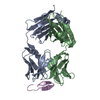
 Components
Components
 Mus musculus (house mouse) / Cell (production host): Hybridoma cell / Production host:
Mus musculus (house mouse) / Cell (production host): Hybridoma cell / Production host: 
 Mus musculus (house mouse)
Mus musculus (house mouse)
 Mus musculus (house mouse) / Cell (production host): Hybridoma cell / Production host:
Mus musculus (house mouse) / Cell (production host): Hybridoma cell / Production host: 
 Mus musculus (house mouse)
Mus musculus (house mouse) Water
Water X-RAY DIFFRACTION / Number of used crystals: 1
X-RAY DIFFRACTION / Number of used crystals: 1  Sample preparation
Sample preparation
 ROTATING ANODE / Type: RIGAKU MICROMAX-007
ROTATING ANODE / Type: RIGAKU MICROMAX-007 Processing
Processing :
:  MOLECULAR REPLACEMENT / Resolution: 1.59→14.18 Å / Cor.coef. Fo:Fc: 0.957 / Cor.coef. Fo:Fc free: 0.926 / SU B: 5.046 / SU ML: 0.087 / TLS residual ADP flag: LIKELY RESIDUAL / Cross valid method: THROUGHOUT / ESU R: 0.126 / ESU R Free: 0.13 / Stereochemistry target values: MAXIMUM LIKELIHOOD / Details: HYDROGENS HAVE BEEN ADDED IN THE RIDING POSITIONS
MOLECULAR REPLACEMENT / Resolution: 1.59→14.18 Å / Cor.coef. Fo:Fc: 0.957 / Cor.coef. Fo:Fc free: 0.926 / SU B: 5.046 / SU ML: 0.087 / TLS residual ADP flag: LIKELY RESIDUAL / Cross valid method: THROUGHOUT / ESU R: 0.126 / ESU R Free: 0.13 / Stereochemistry target values: MAXIMUM LIKELIHOOD / Details: HYDROGENS HAVE BEEN ADDED IN THE RIDING POSITIONS Movie
Movie Controller
Controller


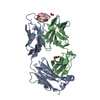

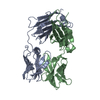
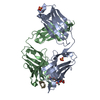

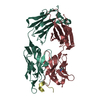


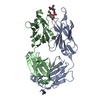
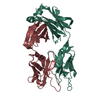
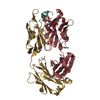

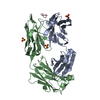

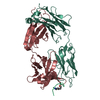
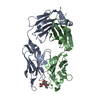

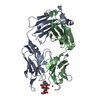
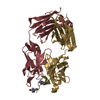
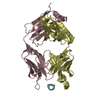
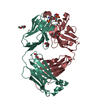

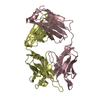
 PDBj
PDBj















